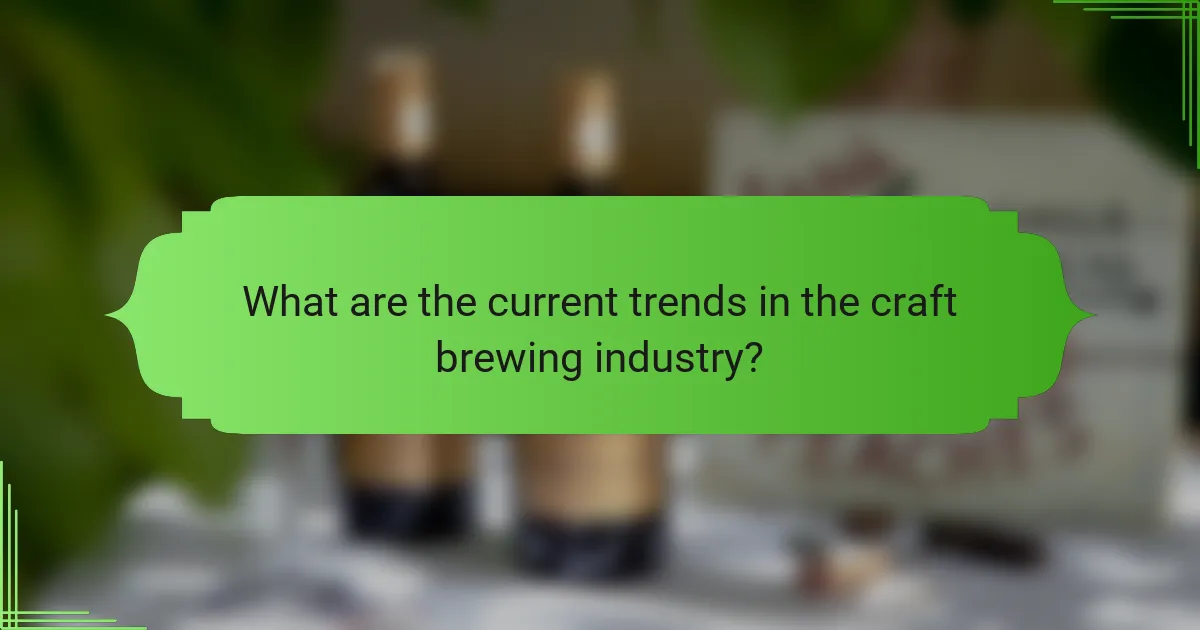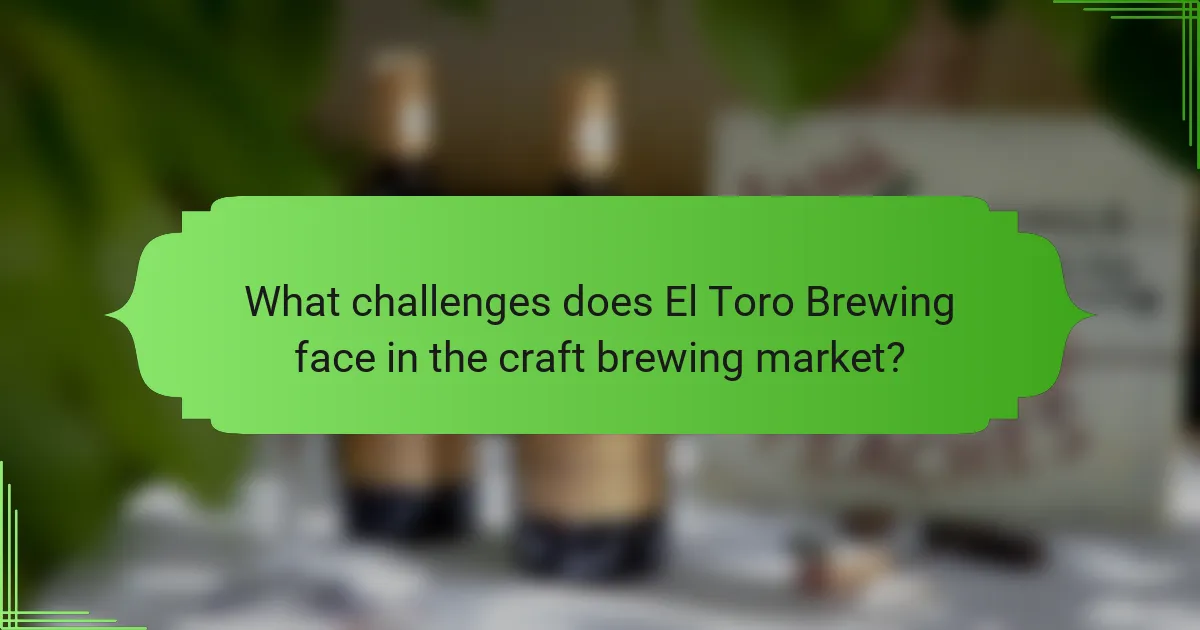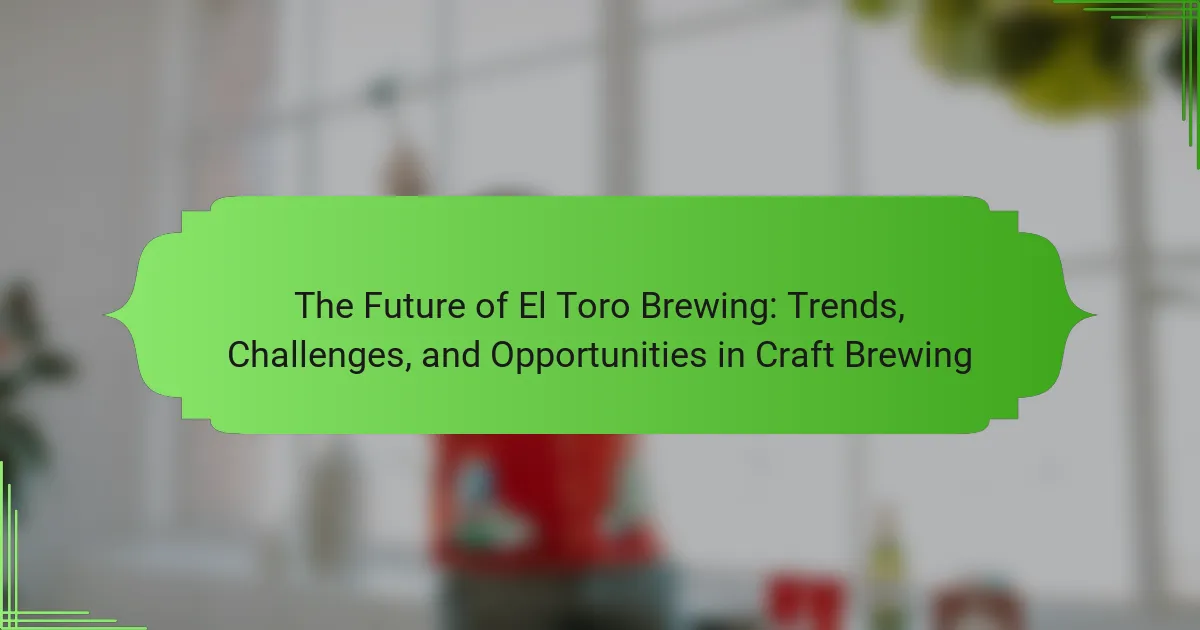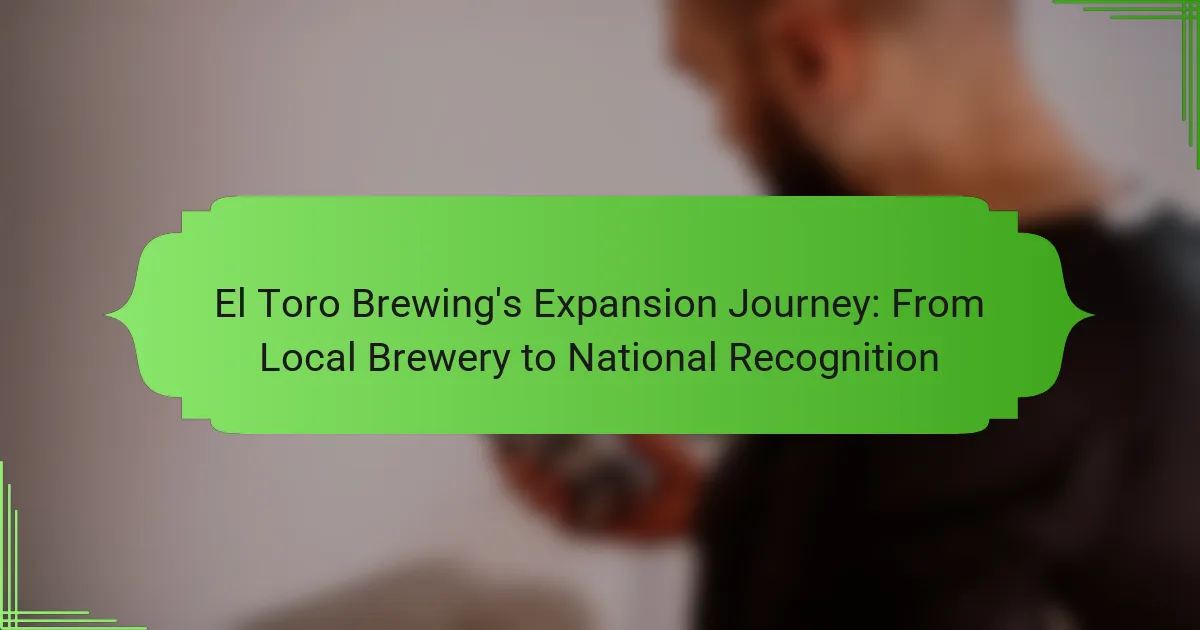El Toro Brewing is a craft brewery navigating a dynamic landscape marked by trends, challenges, and opportunities. Current trends in the craft brewing industry include a focus on sustainability, local sourcing, unique flavors, and non-alcoholic options, driven by changing consumer preferences towards health and wellness. El Toro faces challenges such as increased competition, rising production costs, and regulatory hurdles, while also having opportunities to leverage growing consumer demand for distinctive beers and sustainable practices. The rise of e-commerce and collaborative efforts with local businesses further enhance El Toro’s potential for market engagement and brand visibility. This article explores these trends, challenges, and opportunities shaping the future of El Toro Brewing in the craft brewing sector.

What are the current trends in the craft brewing industry?
Current trends in the craft brewing industry include a focus on sustainability and local sourcing. Many breweries are adopting eco-friendly practices to reduce their environmental impact. This includes using renewable energy and minimizing waste. Additionally, there is a rising demand for unique flavors and styles. Craft brewers are experimenting with unconventional ingredients like fruits, herbs, and spices.
Another trend is the growth of non-alcoholic options. Many consumers are seeking alcohol-free or low-alcohol beverages. This shift reflects changing attitudes towards health and wellness. Furthermore, collaborations between breweries are becoming more common. These partnerships often result in innovative and limited-edition beers.
Lastly, the use of technology in brewing processes is increasing. Breweries are utilizing data analytics to enhance production efficiency and quality. These trends indicate a dynamic and evolving craft brewing landscape.
How is consumer preference evolving in craft brewing?
Consumer preference in craft brewing is evolving towards unique flavors and local sourcing. More consumers are seeking out diverse beer styles, such as sour ales and IPAs. A shift towards sustainability is also evident, with many preferring breweries that use eco-friendly practices. The demand for transparency in ingredients has increased, driving breweries to disclose sourcing information. Additionally, consumers are gravitating towards smaller, independent breweries over large corporations. This trend is supported by data showing a rise in craft beer sales, which reached $26 billion in 2021. Preferences are increasingly influenced by social media and craft beer culture, shaping consumer choices and brand loyalty.
What role do sustainability and eco-friendliness play in consumer choices?
Sustainability and eco-friendliness significantly influence consumer choices. Many consumers prioritize products that align with their environmental values. Research indicates that 66% of global consumers are willing to pay more for sustainable brands. Brands that demonstrate eco-friendly practices often see increased customer loyalty. Additionally, younger generations, such as Millennials and Gen Z, are particularly inclined to support sustainable companies. Consumers frequently seek transparency regarding sourcing and production methods. In the craft brewing industry, breweries adopting sustainable practices can differentiate themselves in a competitive market. This trend reflects a broader societal shift towards environmental consciousness.
How are flavor innovations influencing craft beer popularity?
Flavor innovations are significantly influencing craft beer popularity by attracting diverse consumer preferences. Unique flavors such as fruit, spices, and herbs create distinct experiences. These innovations cater to adventurous drinkers seeking variety. According to a 2022 study by the Brewers Association, 60% of craft beer drinkers prioritize unique flavors. This trend leads to increased experimentation among breweries. As a result, craft breweries are expanding their offerings to include seasonal and limited-edition brews. The variety enhances customer engagement and loyalty. Consequently, flavor innovation plays a crucial role in driving sales and market growth in the craft beer industry.
What technological advancements are shaping the future of craft brewing?
Technological advancements such as automation, data analytics, and sustainable practices are shaping the future of craft brewing. Automation improves efficiency in brewing processes. This includes automated brewing systems and robotic packaging lines. Data analytics enables brewers to optimize recipes and monitor fermentation in real-time. This leads to consistent quality and reduced waste. Sustainable practices, including energy-efficient brewing equipment, are becoming essential. These innovations help reduce the environmental impact of brewing. Additionally, advancements in ingredient sourcing, like lab-grown hops and yeast, are emerging. These technologies allow for unique flavor profiles and greater sustainability. Overall, these advancements are transforming the craft brewing industry into a more efficient and environmentally friendly sector.
How is automation impacting brewing processes?
Automation is significantly enhancing brewing processes by improving efficiency and consistency. Automated systems streamline tasks such as ingredient measurement, fermentation control, and packaging. This reduces human error and ensures precise brewing conditions. For instance, automated temperature control systems maintain optimal fermentation temperatures, leading to better flavor profiles. Additionally, automation allows for real-time monitoring of brewing parameters. This data-driven approach enables brewers to make informed adjustments quickly. Research shows that breweries implementing automation can increase production rates by up to 30%. Thus, automation not only boosts productivity but also enhances product quality in brewing.
What are the benefits of using data analytics in craft brewing?
Data analytics in craft brewing enhances decision-making and operational efficiency. It allows brewers to analyze consumer preferences and trends. This leads to improved product development and targeted marketing strategies. Analytics can optimize inventory management, reducing waste and costs. Breweries can also monitor brewing processes for quality control. This results in consistently high-quality products. Furthermore, data analytics aids in forecasting demand, ensuring better resource allocation. According to a study by the Brewers Association, breweries using analytics report a 15% increase in sales efficiency.

What challenges does El Toro Brewing face in the craft brewing market?
El Toro Brewing faces several challenges in the craft brewing market. Increased competition is a significant hurdle, as numerous craft breweries emerge each year. This saturation makes it difficult for El Toro to differentiate its products. Additionally, rising costs of ingredients and production impact profitability. Regulatory challenges also pose obstacles, with compliance requirements becoming more stringent. Market trends indicate a shift towards health-conscious beverages, which may require El Toro to adapt its offerings. Consumer preferences are rapidly changing, making it essential for the brewery to stay innovative. Distribution challenges can limit market reach and affect sales growth. Finally, maintaining brand loyalty in a crowded market is crucial for sustained success.
How does competition affect El Toro Brewing’s market position?
Competition significantly impacts El Toro Brewing’s market position by influencing pricing, product innovation, and brand visibility. The craft brewing industry is characterized by a high number of competitors. These competitors drive El Toro Brewing to differentiate its offerings. They must innovate to meet consumer preferences and trends. This innovation can lead to new product lines or unique flavors.
Additionally, competition pressures El Toro Brewing to maintain competitive pricing. If prices are too high, consumers may switch to alternative brands. Market visibility is also affected by competition. Strong marketing strategies are essential to attract and retain customers.
In regions with many breweries, local competition can diminish market share. For instance, if a new brewery opens nearby, it may divert customers from El Toro Brewing. Overall, competition shapes El Toro Brewing’s strategies for growth and sustainability in the craft beer market.
What strategies can El Toro Brewing employ to differentiate itself?
El Toro Brewing can differentiate itself by focusing on unique brewing techniques and local ingredients. Implementing innovative flavors can attract craft beer enthusiasts. Collaborating with local farms for fresh produce enhances product quality. Offering limited-edition brews can create excitement and exclusivity. Engaging in community events fosters brand loyalty. Developing a strong online presence can increase visibility and customer engagement. Providing exceptional customer service enhances the overall experience. Lastly, implementing sustainable practices can appeal to environmentally conscious consumers.
How does regulatory compliance impact El Toro Brewing’s operations?
Regulatory compliance significantly impacts El Toro Brewing’s operations by dictating production standards and operational procedures. Compliance with local, state, and federal regulations ensures that the brewing processes meet safety and quality requirements. This includes adherence to health codes, labeling laws, and environmental regulations. Failing to comply can lead to fines, legal issues, and damage to the brand’s reputation. Furthermore, compliance affects inventory management and distribution practices. It requires El Toro Brewing to maintain thorough documentation and regular audits. This structured approach can enhance operational efficiency and consumer trust. Compliance also influences market access, as certain regulations may restrict sales in specific regions. Overall, regulatory compliance shapes the operational landscape for El Toro Brewing, impacting both costs and strategic decisions.
What economic factors influence the craft brewing landscape?
Economic factors influencing the craft brewing landscape include market demand, production costs, and competition. Market demand for craft beer has surged, reflecting consumer preferences for unique flavors and local products. This increased demand encourages new breweries to enter the market. Production costs, including raw materials and labor, directly affect pricing and profitability. Fluctuations in the cost of ingredients, such as hops and malt, can impact the overall financial health of breweries. Competition is intense among craft brewers, leading to innovation and marketing strategies aimed at attracting consumers. Additionally, regulatory expenses can influence operational costs, affecting the viability of smaller breweries. The economic environment, including disposable income levels and consumer spending habits, also plays a crucial role in shaping the craft brewing industry.
How do supply chain issues affect El Toro Brewing’s production?
Supply chain issues significantly hinder El Toro Brewing’s production capabilities. Delays in raw material delivery can lead to interruptions in brewing schedules. For example, shortages of key ingredients like hops or malt can reduce batch sizes. Additionally, transportation disruptions can extend lead times for essential supplies. This results in increased operational costs and potential loss of sales. Furthermore, inconsistent inventory levels can affect product availability in the market. Historical data shows that similar breweries have faced production declines of up to 20% during supply chain disruptions. Such challenges require El Toro Brewing to adapt its sourcing strategies to maintain production efficiency.
What is the impact of rising ingredient costs on craft breweries?
Rising ingredient costs significantly impact craft breweries by increasing production expenses. Higher prices for key ingredients like malt, hops, and yeast can squeeze profit margins. This forces breweries to either raise retail prices or absorb costs, which can affect competitiveness. According to the Brewers Association, ingredient costs account for about 25% of a brewery’s total expenses. Additionally, small breweries may struggle more than larger ones due to limited purchasing power. In 2022, the price of hops rose by nearly 20%, impacting breweries’ ability to maintain pricing and profit levels. Consequently, craft breweries must adapt by innovating recipes or sourcing alternative ingredients.

What opportunities lie ahead for El Toro Brewing in the craft brewing sector?
El Toro Brewing has several opportunities in the craft brewing sector. The growing consumer demand for unique and locally sourced beers presents a significant market for El Toro. Craft beer sales have increased consistently, with a reported growth rate of approximately 4% annually in the U.S. This trend indicates a favorable environment for new and innovative breweries. Additionally, the rise of e-commerce and direct-to-consumer sales channels allows El Toro to reach customers more effectively. Collaborations with local businesses and participation in craft beer festivals can enhance brand visibility and customer engagement. Furthermore, sustainable brewing practices are becoming more important to consumers, providing El Toro a chance to differentiate itself through eco-friendly initiatives. These factors collectively position El Toro Brewing to capitalize on emerging trends in the craft brewing market.
How can El Toro Brewing expand its market reach?
El Toro Brewing can expand its market reach by diversifying its product offerings. Introducing new beer styles can attract different customer segments. Collaborating with local restaurants for exclusive brews can enhance visibility. Implementing an online sales platform can reach customers beyond local markets. Participating in craft beer festivals can increase brand awareness. Expanding distribution channels to include grocery stores can boost sales. Targeting untapped demographics, such as younger consumers, can drive growth. Utilizing social media marketing can engage a broader audience effectively.
What are the potential benefits of collaborations with local businesses?
Collaborations with local businesses can enhance brand visibility and community engagement. Such partnerships often lead to shared marketing efforts, increasing reach to a broader audience. For example, joint events can attract more customers than individual efforts. Additionally, these collaborations can foster innovation through shared resources and ideas. This exchange often results in unique product offerings that appeal to local consumers. Studies show that businesses involved in local collaborations experience higher customer loyalty. According to a survey by the American Independent Business Alliance, locally owned businesses gain 70% more customers when they collaborate with other local entities. Overall, collaborations can drive growth and strengthen community ties.
How can El Toro Brewing leverage social media for brand growth?
El Toro Brewing can leverage social media for brand growth by engaging with its audience through interactive content. This includes polls, Q&A sessions, and live events that create a sense of community. Posting visually appealing images of their craft beers can attract attention and encourage shares. Collaborating with local influencers can expand their reach and introduce the brand to new customers.
Utilizing targeted ads on platforms like Facebook and Instagram can help reach specific demographics. Consistent posting schedules can keep the audience engaged and informed about new releases and events. Monitoring analytics will provide insights into what content resonates most with their followers, allowing for data-driven adjustments.
According to a 2021 report by the Brewer’s Association, breweries that actively engage on social media see a significant increase in customer loyalty and brand awareness.
What new product developments could El Toro Brewing explore?
El Toro Brewing could explore the development of non-alcoholic craft beers. This market segment is rapidly growing, with a 20% increase in sales reported in 2022. They might also consider creating limited-edition seasonal brews to attract craft beer enthusiasts. Seasonal beers can drive sales during specific times of the year, enhancing customer engagement. Additionally, incorporating local ingredients into their recipes could appeal to the farm-to-table trend. This approach supports local agriculture and can differentiate their products in a crowded market. Another opportunity is to develop flavored seltzers, which have gained popularity among health-conscious consumers. This aligns with the trend towards lighter, low-calorie beverages. Finally, El Toro Brewing could innovate by offering subscription services for exclusive releases. This model has proven successful for various craft breweries, fostering customer loyalty.
How can El Toro Brewing tap into the non-alcoholic beverage trend?
El Toro Brewing can tap into the non-alcoholic beverage trend by developing a line of non-alcoholic craft beers. This aligns with the growing consumer demand for healthier beverage options. In 2022, the non-alcoholic beer market was valued at approximately $25 billion and is projected to grow significantly. El Toro Brewing can leverage its brewing expertise to create unique flavors that appeal to non-drinkers. Collaborating with local health-focused retailers can enhance visibility. Additionally, marketing campaigns highlighting the benefits of non-alcoholic options can attract a broader audience. Engaging with consumers through tastings and events can further promote these products.
What role can seasonal and limited-edition brews play in attracting customers?
Seasonal and limited-edition brews play a significant role in attracting customers. They create a sense of urgency and exclusivity. This encourages consumers to try something new before it’s gone. Seasonal brews often align with holidays or events, enhancing their appeal. For example, pumpkin ales are popular in the fall. Limited-edition releases can showcase unique ingredients or brewing techniques. This attracts craft beer enthusiasts looking for novel experiences. Research indicates that 60% of craft beer drinkers seek out seasonal offerings. This highlights the demand for variety and innovation in the market.
What best practices can El Toro Brewing adopt for sustainable growth?
El Toro Brewing can adopt several best practices for sustainable growth. First, they should focus on sourcing local ingredients. This reduces transportation emissions and supports local farmers. Second, implementing energy-efficient brewing processes can lower operational costs. Studies show that energy-efficient systems can reduce energy consumption by up to 30%. Third, engaging in community initiatives can enhance brand loyalty. Research indicates that businesses involved in local causes see a 20% increase in customer retention. Fourth, adopting sustainable packaging options can appeal to eco-conscious consumers. Brands using recyclable materials report higher sales among environmentally aware demographics. Lastly, investing in staff training fosters a knowledgeable workforce. A skilled team can improve product quality and customer service, driving repeat business.
How can El Toro Brewing implement effective marketing strategies?
El Toro Brewing can implement effective marketing strategies by leveraging social media, hosting community events, and creating unique branding. Social media platforms like Instagram and Facebook can showcase their craft beers and engage with customers. Hosting local events, such as beer tastings or brewery tours, fosters community involvement and brand loyalty. Unique branding, including eye-catching labels and storytelling about their brewing process, helps differentiate their products in a competitive market. Research indicates that breweries with strong community ties and effective social media presence see increased customer engagement and sales.
What operational efficiencies can El Toro Brewing pursue for profitability?
El Toro Brewing can pursue several operational efficiencies to enhance profitability. Streamlining production processes can reduce waste and lower costs. Implementing energy-efficient equipment can decrease utility expenses significantly. Optimizing inventory management can minimize excess stock and associated holding costs. Enhancing supply chain logistics can improve delivery times and reduce transportation costs. Utilizing data analytics can provide insights for better decision-making and resource allocation. Investing in employee training can increase productivity and reduce errors. Collaborating with local suppliers can lower transportation costs and support community engagement. These strategies, when effectively implemented, can lead to improved profit margins and overall business sustainability.
El Toro Brewing is a craft brewery navigating a dynamic landscape characterized by current trends, challenges, and opportunities within the industry. Key trends include a focus on sustainability, the rise of non-alcoholic options, and flavor innovations that cater to evolving consumer preferences. The article explores the impact of competition, regulatory compliance, and economic factors on El Toro’s market position. Additionally, it discusses strategies for differentiation, market expansion, and the implementation of operational efficiencies to ensure sustainable growth and profitability. Overall, the content provides a comprehensive analysis of the factors shaping the future of El Toro Brewing in the craft brewing sector.


